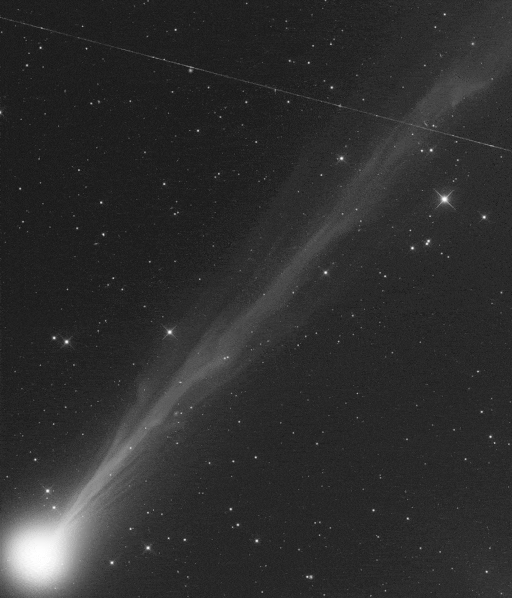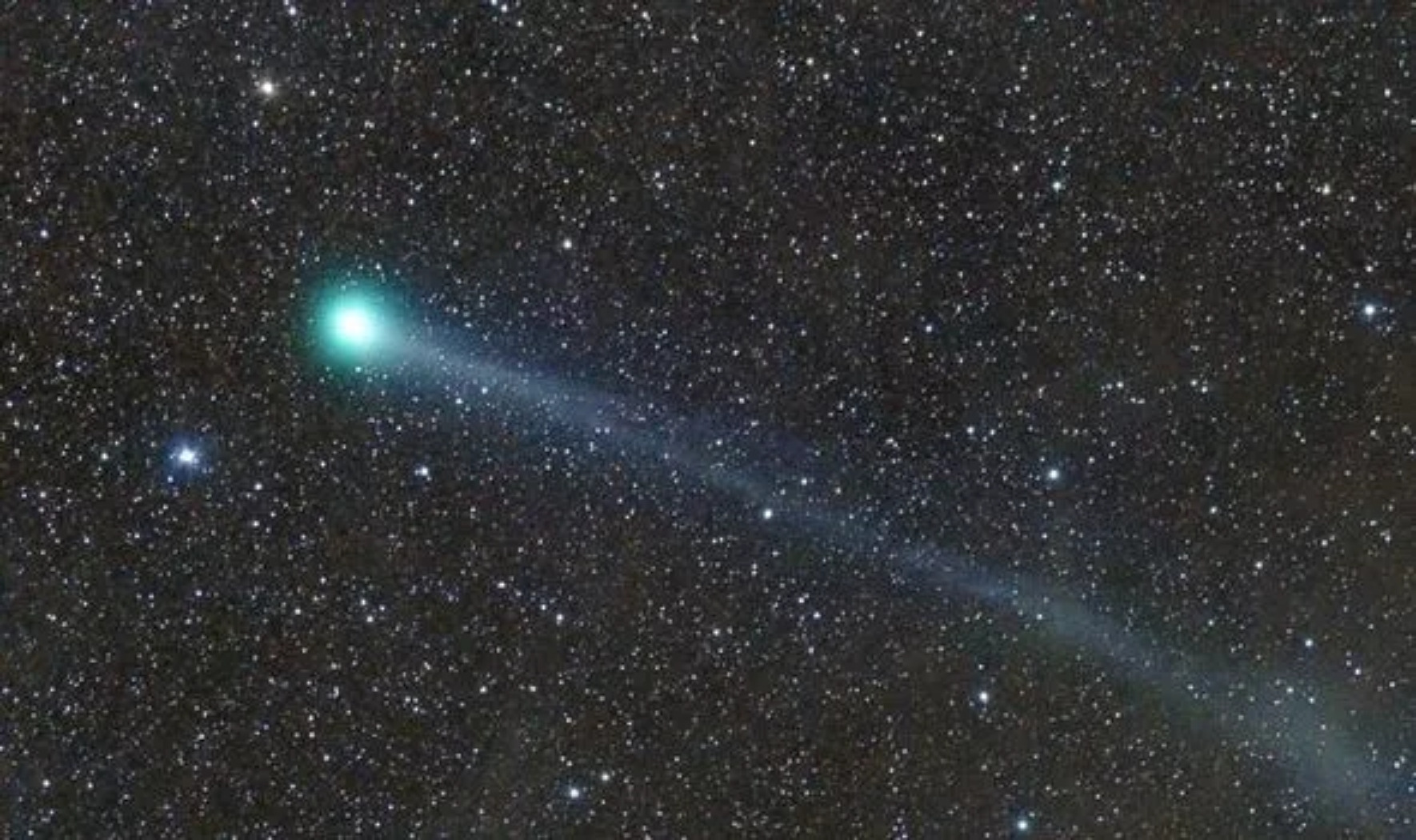It looks like you're using an Ad Blocker.
Please white-list or disable AboveTopSecret.com in your ad-blocking tool.
Thank you.
Some features of ATS will be disabled while you continue to use an ad-blocker.
17
share:
What happened? It might have fragmented, exposing bright clouds of dusty gas to the sun. Certainly the comet's tail looks like debris from an explosion:
But Karl Battams of the Naval Research Lab in Washington, DC, doesn’t think so. "Outbursts do not necessarily imply fragmentation, and ground-based images are not yet showing evidence of a breakup," he says. "This could just be a particularly feisty and volatile comet."
Comet SWAN was discovered on April 11th when Australian amateur astronomer Michael Mattiazzo noticed a curious "bloom" in images from SOHO's SWAN camera. SWAN surveys the solar system for hydrogen gas, and it caught the comet making a sudden hydrogen dump. That might have been Comet SWAN’s first outburst.
WHAT JUST HAPPENED TO COMET SWAN?
Comet SWAN (C/2020 F8) had a mysterious outburst this week. It was able to be seen in the southern hemisphere with the naked eye.
SWAN has a hyperbolic orbit and that means it is likely the comet has never come close to our Sun before or any other star for that matter.
Fresh comets like SWAN seem to be very unpredictable. The heat of a Sun it has never felt before, melts the comet's outer layers and it exposes volatile material.
This can cause fracturing, cracking and out gassing of different substances. Which can cause the comet to get brighter and even fall apart or fragment.
Great video ! There was an announcement about the new Space Force joining with NASA to help detect NEOs and any other objects that might threaten to
strike earth. If detected you have to wonder what are they capable of doing other than bending over and assuming the position ?
a reply to: 727Sky
As long as it is detected with years to spare we may be able to change it's course in a few different ways.
Otherwise all we can do is launch nukes at it, if there is enough time.
This is the last ditch effort, may not help and could make it worst. I think it would be done, if the rock was big enough to do major damage to the Earth.
As long as it is detected with years to spare we may be able to change it's course in a few different ways.
Otherwise all we can do is launch nukes at it, if there is enough time.
This is the last ditch effort, may not help and could make it worst. I think it would be done, if the rock was big enough to do major damage to the Earth.
edit on 6-5-2020 by LookingAtMars because: (no reason given)
Huh. Whatever caused it is is sure purty.
Hmm .. Two major comets, ATLAS and SWAN, near enough to see , so far, not even half way through this eventful year.
I'm beginning to wonder if the superstitions of yesteryear re: comets wasn't based on some reality, however circumspect.
Either way, is it my skewed perception or is there more "debris" in our system than is usual?
On the bright side, if we are to be fated for death by asteroid, at least it is either a fast death or one with a spectacular view.
For the fraidy cats and less informed about space stuff, I'm being silly and we are far more threatened by germs, environmental damage and psychotic leadership than by space events.
Hmm .. Two major comets, ATLAS and SWAN, near enough to see , so far, not even half way through this eventful year.
I'm beginning to wonder if the superstitions of yesteryear re: comets wasn't based on some reality, however circumspect.
Either way, is it my skewed perception or is there more "debris" in our system than is usual?
On the bright side, if we are to be fated for death by asteroid, at least it is either a fast death or one with a spectacular view.
For the fraidy cats and less informed about space stuff, I'm being silly and we are far more threatened by germs, environmental damage and psychotic leadership than by space events.
a reply to: Baddogma
The Earth is now traveling through the debris of Haley's Comet.
Could a comet be virus ridden and could the virus make it into our atmosphere alive?
If anything "living" could do it, it would be a virus, maybe a water bear or an ET in a UFO (of course).
.
I'm beginning to wonder if the superstitions of yesteryear re: comets wasn't based on some reality, however circumspect.
Either way, is it my skewed perception or is there more "debris" in our system than is usual?
The Earth is now traveling through the debris of Haley's Comet.
Could a comet be virus ridden and could the virus make it into our atmosphere alive?
If anything "living" could do it, it would be a virus, maybe a water bear or an ET in a UFO (of course).
.
a reply to: LookingAtMars
Water bears are awesome
And so are ET
Viruses eh....cool too.
I Wonder if there are virulent water bears? I suppose they could get infected with something. A virus sitting inactive inside a water bear that's dehydrated in deep space could potentially "live" for millions of years.
There are virulent ET's for sure
Water bears are awesome
And so are ET
Viruses eh....cool too.
I Wonder if there are virulent water bears? I suppose they could get infected with something. A virus sitting inactive inside a water bear that's dehydrated in deep space could potentially "live" for millions of years.
There are virulent ET's for sure
a reply to: LookingAtMars
1. From whence do you imagine the viruses may have originated?
2. Do you suppose that any such virus would be based upon RNA/DNA?
3. Highly doubtful.
Could a comet be virus ridden and could the virus make it into our atmosphere alive?
1. From whence do you imagine the viruses may have originated?
2. Do you suppose that any such virus would be based upon RNA/DNA?
3. Highly doubtful.
edit on 5/7/2020 by Phage because: (no reason given)
a reply to: Phage
natureworldtoday.com...
orionsunset.com...
natureworldtoday.com...
“Every day, more than 800 million viruses are deposited per square meter (11 sq ft) above the planetary boundary layer,” explained study co-author Curtis Suttle, a virologist at the University of British Columbia, according to Newsweek
The planetary boundary layer — which rests in the lowest part of the troposphere — moves and responds to conditions at the Earth’s surface. In this new research, the team went beyond that and measured viruses in the upper troposphere. That is because viruses can be swept up by various natural shifts that causes them to soar thousands of miles through the air before coming back to Earth.
orionsunset.com...
The Mystery Of Life On Earth
The idea that life was seeded on Earth by objects hitting the Earth makes perfect sense. Scientists already believe that this is how much of the material on Earth ended up here. Most scientist believe that this is how water ended up on Earth. After the Earth cooled, meteorites ravaged the planet carrying all the elements which make our planet so diverse. Everything from precious metals to hydrogen probably came from off-world objects. If meteors, comets and asteroids brought water to Earth then it is safe to assume that there were biological materials and microbes in the water that they brought. One would think that mainstream scientist’s would be on board with the idea of Panspermia
If most of the material on Earth came from off of the Earth, then that means most life could have too. Have you ever heard the saying “we are all just stardust”? Assuming this is true then Panspermia is a discussion about when and how life was seeded on Earth, not if.
a reply to: 727Sky
I have no idea what the first quote has to do with the question.
Your second quote, "it is safe to assume?" Is it really? I think it's safer to assume that life began right here on Earth.
But but in regard to a comet (you know, the topic), I will refer you again to the two questions I posed above.
I have no idea what the first quote has to do with the question.
Your second quote, "it is safe to assume?" Is it really? I think it's safer to assume that life began right here on Earth.
But but in regard to a comet (you know, the topic), I will refer you again to the two questions I posed above.
edit on 5/8/2020 by Phage because: (no reason given)
I have noticed that a sudden unexpected increase in brightness often happens before a comet breaks up. This maybe be happening to SWAN which is
unfortunate because it is still a week or two from being visible in the Northern Hemisphere.
I hope I am wrong.
I hope I am wrong.
Comet SWAN: How to see the
comet this month - 'Best comet' seen in years
Comet SWAN will be closest to Earth on the night of May 12 to May 13, passing by from a distance of about 0.56 astronomical units - more than half the distance to the Sun.
Although the comet will be better seen in the Southern Hemisphere, it will still be possible to see it from the UK.
The Lancaster University Astronomy Society tweeted: "Comet SWAN @c2020f8 is visible to the naked eye!
"It'll be an early morning object for us in the UK, and we're hoping it'll hold long enough to reach its closest approach on May 13... eyes east."
edit on 10-5-2020 by LookingAtMars because: (no reason given)
new topics
-
Most Complex Backyard Rube Goldberg Machine You'll See All Day
General Chit Chat: 1 hours ago
top topics
-
Of course it was DEI
Dissecting Disinformation: 13 hours ago, 9 flags -
2nd Day Thanksgiving!...(leftovers!!)
General Chit Chat: 14 hours ago, 3 flags -
Most Complex Backyard Rube Goldberg Machine You'll See All Day
General Chit Chat: 1 hours ago, 3 flags
active topics
-
I thought Trump was the existential threat?
World War Three • 128 • : JadedGhost -
Of course it was DEI
Dissecting Disinformation • 13 • : network dude -
population madness
New World Order • 21 • : Xtrozero -
Most Complex Backyard Rube Goldberg Machine You'll See All Day
General Chit Chat • 3 • : rickymouse -
V.P. Kamala Harris releases a video and nobody understands why
US Political Madness • 103 • : Xtrozero -
Mass UAP events. DC. Machester Airport, UFOs over sub base in CT, Nuke bases.
Aliens and UFOs • 31 • : alldaylong -
Encouraging News Media to be MAGA-PAF Should Be a Top Priority for Trump Admin 2025-2029.
Education and Media • 83 • : fringeofthefringe -
-@TH3WH17ERABB17- -Q- ---TIME TO SHOW THE WORLD--- -Part- --44--
Dissecting Disinformation • 3418 • : fringeofthefringe -
Unidentified Flying Objects Over U.S. Military Bases in Northeast UK, as of roughly 11 a.m. CST.
Aliens and UFOs • 34 • : bastion -
Post A Funny (T&C Friendly) Pic Part IV: The LOL awakens!
General Chit Chat • 7850 • : KrustyKrab
17


